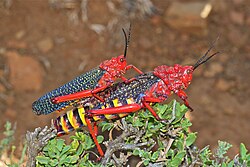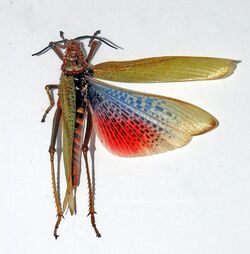Biology:Phymateus
| Phymateus | |
|---|---|

| |
| Phymateus morbillosus, mating pair | |

| |
| Phymateus karschi from Mozambique | |
| Scientific classification | |
| Domain: | Eukaryota |
| Kingdom: | Animalia |
| Phylum: | Arthropoda |
| Class: | Insecta |
| Order: | Orthoptera |
| Suborder: | Caelifera |
| Family: | Pyrgomorphidae |
| Subfamily: | Pyrgomorphinae |
| Tribe: | Phymateini |
| Genus: | Phymateus Thunberg 1815 |
Phymateus is a genus of fairly large grasshoppers of the family Pyrgomorphidae, native to shrubland, semi-deserts, savanna, woodland, gardens and cultivated areas in Sub-Saharan Africa, with ten species in the African mainland and two species in Madagascar .[1][2] Some species have bright aposematic colours and are highly toxic.[2][3]
Description
Phymateus are African grasshoppers that typically are about 4–8.5 cm (1.6–3.3 in) long as adults, with females generally being larger than males of the same species.[3] Some species at maturity are capable of long migratory flights. They raise and rustle wings when disturbed and may secrete a noxious fluid from the thoracic joint.[4] Their toxins, which are accumulated from the toxic plants they feeed on, can be very strong and there have been reported deaths in birds and mammals, including humans, after eating Phymateus grasshoppers.[3][5] While they do show a preference for feeding on certain toxic plants, notably Asclepias milkweeds, they will feed on a wide range of plants, and are sometimes regarded as pests because of the damage they may cause to agricultural crops.[2][6] They may congregate in large numbers on trees and shrubs, in some species arranged in such a way as to resemble foliage. Other species have bright aposematic warning colours. Although adults of both sexes are fully winged, in at least P. morbillosus the females, which are longer and considerably heavier than males, are unable to fly.[7]
List of species
The Orthoptera Species File lists:[1]
- subgenus Maphyteus Bolívar, 1904
- Phymateus baccatus Stål, 1876
- Phymateus leprosus (Fabricius, 1793)
- subgenus Phymateus Thunberg, 1815
- Phymateus aegrotus (Gerstaecker, 1869)
- Phymateus bolivari Kirby, 1910
- Phymateus cinctus (Fabricius, 1793)
synonyms: P. stolli (Saussure, 1861) = P. flavus (I. Bolivar, 1903) = P. squarrosus (Houttuyn, 1813) - Phymateus iris Bolívar, 1882
- Phymateus karschi Bolívar, 1904
- Phymateus madagassus Karsch, 1888
- Phymateus morbillosus (Linnaeus, 1758) = type species (as Gryllus morbillosus L.)
- Phymateus pulcherrimus (I. Bolívar, 1904)
- Phymateus saxosus (Coquerel, 1862)
- Phymateus viridipes Stål, 1873[8]
Gallery
References
- ↑ 1.0 1.1 Orthoptera Species File: Genus Phymateus
- ↑ 2.0 2.1 2.2 Köhler, S.; Roth, S.; Reinhardt, K. (2007). "Ten Instars in the Leprous Grasshopper, Phymateus leprosus (Fabricius, 1793) (Caelifera: Pyrgomorphidae): Maximum Number Recorded in the Acridoidea". Bonner zoologische Beiträge 56 (1/2): 17–24.
- ↑ 3.0 3.1 3.2 Whitman, D.; Vincent, S. (2008). "Large size as an antipredator defense in an insect". Journal of Orthoptera Research 17 (2): 353–371. doi:10.1665/1082-6467-17.2.353.
- ↑ Field Guide to Insects - Picker, Griffiths & Weaving (2004)
- ↑ Steyn, D.G. (1962). "Grasshopper (Phymateus leprosus Fabr.) poisoning in a Bantu child". S.A. Medical Journal 36: 822–823.
- ↑ Seibt, U.; Kasang, G.; Wickler, W. (2000). "Suggested Pharmacophagy of the African Bushhopper Phymateus leprosus (Fabricius) (Pyrgomorphidae, Orthoptera)". Z. Naturforsch. C 55 (5–6): 442–448. doi:10.1515/znc-2000-5-621. PMID 10928557.
- ↑ Gäde, G. (2002). "Sexual dimorphism in the pyrgomorphid grasshopper Phymateus morbillosus: from wing morphometry and flight behaviour to flight physiology and endocrinology". Physiological Entomology 27 (1): 51–57. doi:10.1046/j.1365-3032.2002.00268.x.
- ↑ Biolib
External links
Wikidata ☰ Q7189450 entry
 |






